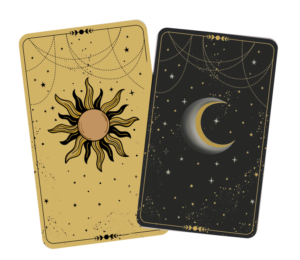
Dual relationships such as the inter-play between above and below, macrocosm and microcosm etc lie at the heart of most cosmological systems. Astrology is no different. Within this context, the predominant influence at work is Pythagorean philosophy, in particular, the tension of polarity, and the shades of grey these create within nature and in our horoscopes.
One of the most ancient ways this was expressed in terms of astrological techniques was via a lesser-known but once ubiquitous system of classification known as sect.
The word ‘sect’ comes from the Latin word seco, meaning to cut or divide.
In essence, sect divides the various elements of astrology into binaries, with the Sun and Moon as the primary sect rulers, similar to the yin and yang principles of Chinese cosmology.
Why these two planets? Probably because the luminaries, as their name suggests, were the two heavenly bodies that illuminated our skies, which set them apart from the other planets in the eyes of early astrologers in terms of their seeming ability to emit light. In alchemy, they are associated with the two precious metals, gold and silver (albeit only when in their purest, most refined forms).
This primary division into opposites and the interplay between light vs dark is a theme we are already familiar with here at AstrologySphere, given our focus on lunar phases and eclipses.
Pythagorean principles
According to Pythagorean principles, the world is constructed from binary opposites, which must be brought into balance in order to create stability within the cosmos (the Greeks called this process harmonia). Pythagoras is alleged to have said:
‘If there be light, then there is darkness; if cold, heat; if height, depth; if solid, fluid; if hard, soft; if rough, smooth; if calm, tempest; if prosperity, adversity; if life, death.’
Pythagoras
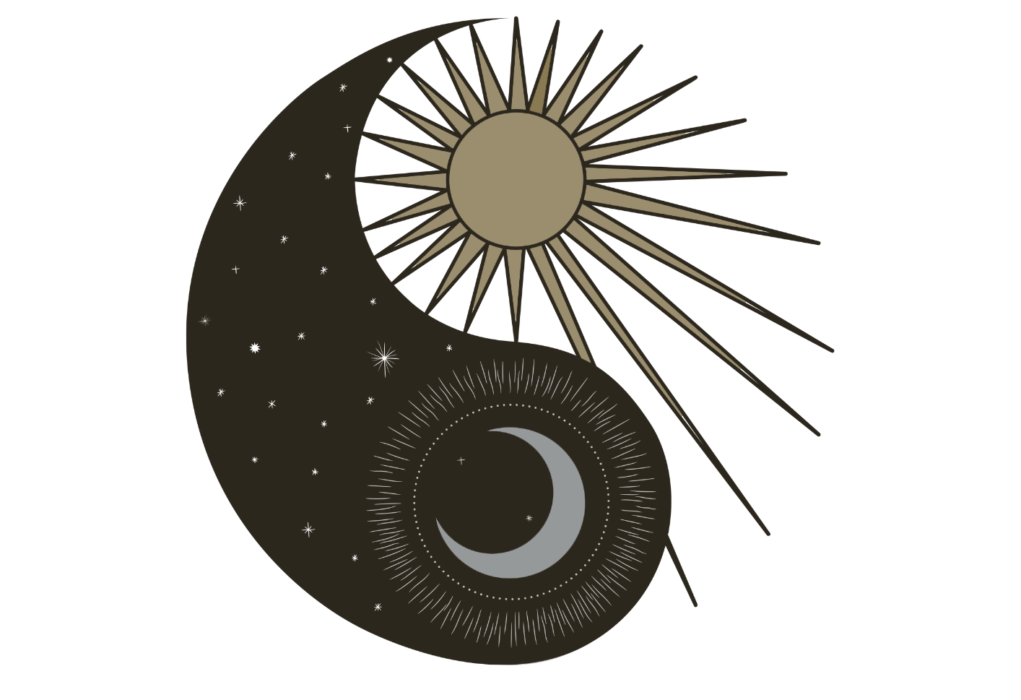
The ancients who developed astrology took these relationships very seriously and integrated them into almost every aspect of horoscopy, from lunar phases to solar stations, the nodes and Arabic parts, the benefic/malefic planets etc. And, of course, sect.
SECT & CHART DIVISION
The oscillation between light and dark that produce the changing conditions that mark out our days, months and seasons, is also represented in astrology by the two lights of the sky – the Sun and Moon.
Each rules over one hemisphere of the horoscope.
The upper half (diurnal hemisphere) represents the realm of day, and of the Sun because it is here that the Sun is to be found between the hours of sunrise and sunset. Ancient astrologers refer to planets in this hemisphere as ‘above the earth’. This could also sometimes refer to the northern hemisphere if one was looking at the globe rather than an astrology chart. In essence, this was considered the more visible half of the horoscope, which is why we find many of the houses in this hemisphere concerned with social and career matters – all aspects of public life.

By contrast, the lower (nocturnal) hemisphere is presided over by the Moon. In horoscopy, this hemisphere represents the more private aspects of life, which is why we find the more hidden and/or personal houses in the lower hemisphere of a horoscope. During the period between sunset and dawn, it is the Moon that reigns supreme over the night skies. In a diurnal chart, her natural hemisphere would be below the earth (southern hemisphere), or line of the horizon (underworld). In nocturnal charts, this is reversed.
Sect vs Sign Modality
The 12 signs of the zodiac were also sub-divided into solar and lunar sects. (See below for a detailed breakdown of the signs)
Sect should not, however, be confused with sign modality, which splits the zodiac into six ‘masculine’ and six ‘feminine’ signs. Nor should these divisions be confused with literal gender or biological sex – rather, they are heavily dependent upon Pythagorean numerology, in which all the positive signs are odd numbered (beginning with the ‘monad’ or first creative principle); and all the negative signs are even-numbered (starting with the dyad, or feminine creative principle) – very similar to the cosmological theory behind Hexagrams 1 and 2 in the I Ching.
This is useful to remember as the so-called ‘gender’ of sun and moon gods tend to vary, depending upon cultural overlays. For instance, in ancient Babylon and Egypt, the Moon was associated with male gods, while in ancient Japan, the Sun is considered to be female. So, in general, it is best to avoid being overly literal (or what I would term ‘modernist’) in this regard.
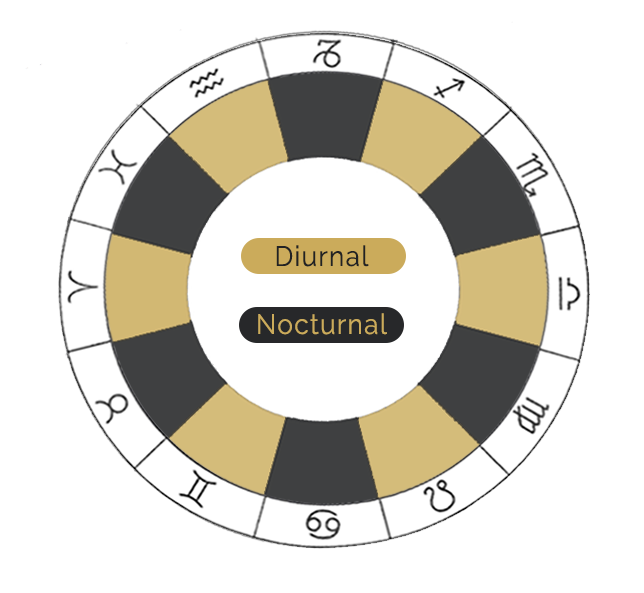
Within the context of sect, however, zodiacal sect is actually more closely related to triplicity, i.e. the qualities of the elements and their affiliations with certain signs: fire and air signs are considered more diurnal or active (e.g. Leo and Libra); while water and earth signs are considered to be more passive or nocturnal. (e.g. Capricorn and Cancer)
This is in keeping with the Pythagorean physics, particularly the theory of the polar archai (or the primordial qualities of matter), namely heat vs coldness, and wetness vs dryness. Ptolemy outlines how these qualities were affiliated with the luminaries in his famous work on natural philosophy, the Tetrabiblos.
Sect & Natural Philosophy
To classical philosophers and scholars, the luminaries were pivotal in many early theories of physics and meteorology because the lights embodied the binary qualities that make up the basic building blocks of all matter – namely, the elements.
According to Ptolemy, the Sun personifies heat and dryness – phenomena we naturally tend to experience during the day – while the Moon is associated with the coolness and moisture of the night. Early scholars believed that it was the dynamic interactions of the archai and elements driven by the luminaries as they waxed and waned in strength and declination etc, that gave us our seasons.
In fact, classical and medieval scholars believed that the ‘waxing and waning’ of the Sun and Moon literally underpinned and regulated most natural processes and cycles. We can therefore see why the luminaries were considered to be so primary, and why they held sway over all the other planets.
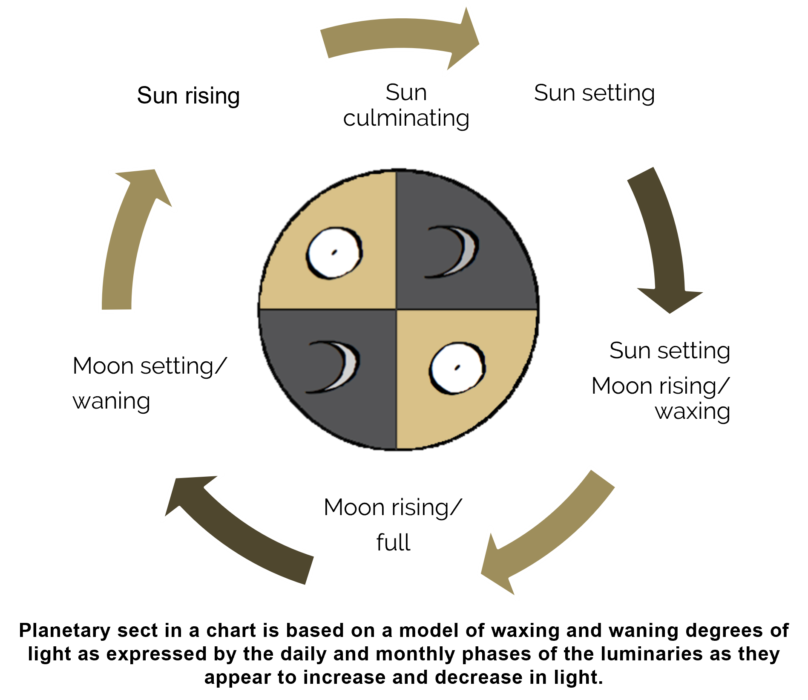
Sect & Planetary dignity
So how was sect used in astrology? Essentially, it was an early system for creating order from chaos – by classifying astrological phenomena into sect, one can sort out what ‘works’ naturally well together and what doesn’t. For example, the Sun thrives in its natural ‘element’ or domain in Leo where it is able to do what it does best: shine and be the proverbial ‘boss’; but is uncomfortable in the sign of its sensitive counterpart, Cancer, which is more shy and retiring, valuing the relative privacy and safety of home and obscuring night where she can be the soft power behind the scenes – the ‘hearth’ of the family. (Bear in mind that we are not talking about literal gender roles here but planetary archetypes, which is why a woman with a Leo Sun can be every bit the ‘she boss’ or have ‘star quality’, and a man with a Cancer Moon can be very empathic/emotionally nurturing, and enjoy a close relationship with his mother, for example. It’s all about the most natural expression of the luminaries. Plus, our horoscopes are a composition of ALL the planets, so each of us contain both solar AND lunar aspects to our natures.)
Although the word ‘sect’ is associated with division, ironically, sect also implies ‘unification through affiliation and common interest (as in a religious sect)’. Sort of like the saying: ‘birds of a feather flock together.’
It is also a way of assessing planetary dignity. This is particularly useful in horary charts, where it can help to predict an outcome by ranking or weighting a planet in terms of its potential strength compared to other planets, and therefore its ability to potentially influence or affect a particular outcome.
Any planet in its proper sect was considered to be strong or favourable: in other words, a planet was thought to function better when in its natural environment, e.g. a diurnal planet (Sun, Jupiter or Saturn) would described as being ‘in sect’ when placed in a diurnal sign and chart area, namely above the horizon, in a chart cast during the day.
Sect predates some of the later systems of dignities introduced by Ptolemy and other Byzantine astrologers (as well as the discovery of the outer planets – an event that only became possible after the invention of the telescope) and so only applies to the traditional seven planets that were visible to the naked eye.
Below are some of the key affiliations or groupings created by sect.
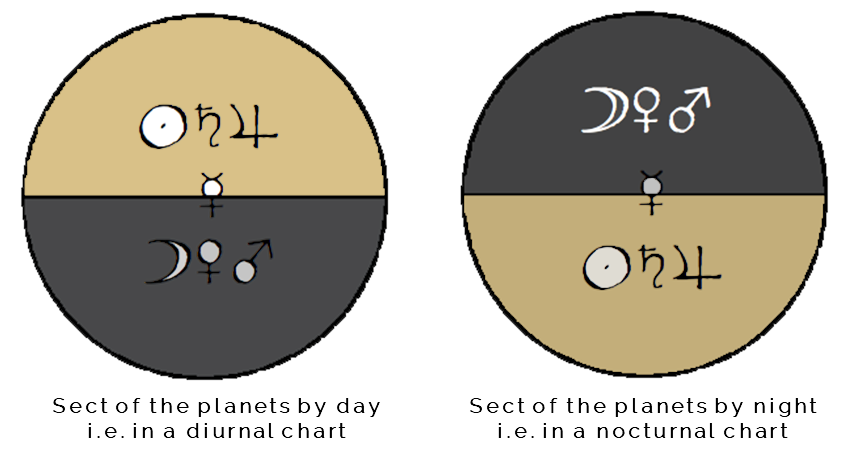
Sect-based Classifications
- Of the seven original planets, The Sun, Jupiter, and Saturn were considered to be diurnal.
- Planets considered nocturnal were: The Moon, Venus, Mars.
- As a liminal planet, Mercury is unique in having no affiliation to either sect, but is usually considered to be diurnal as a morning star and nocturnal as an evening star.
- Zodiac signs considered to be diurnal are: Aries, Gemini, Leo, Libra, Sagittarius and Aquarius.
- Signs considered nocturnal and therefore under the lunar sect are: Taurus, Cancer, Virgo, Scorpio, Capricorn and Pisces.
